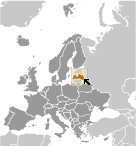World Atlas: Latvia. On this page you can see the map, country flag and many detailed information about the people, history and economy of Latvia.

Here you can find online selected information about the geography, inhabitants, government, economy and history of Latvia. Included are selected statistics, an overview map and the detailed map of Latvia. But let's start with the flag of Latvia here:
Latvia - Overview:
What you should know about Latvia? Let's start with this: Several eastern Baltic tribes merged in medieval times to form the ethnic core of the Latvian people (ca. 8th-12th centuries A.D.). The region subsequently came under the control of Germans, Poles, Swedes, and finally, Russians. A Latvian republic emerged following World War I, but it was annexed by the USSR in 1940 - an action never recognized by the US and many other countries. Latvia reestablished its independence in 1991 following the breakup of the Soviet Union. Although the last Russian troops left in 1994, the status of the Russian minority (some 26% of the population) remains of concern to Moscow. Latvia acceded to both NATO and the EU in the spring of 2004; it joined the euro zone in 2014 and the OECD in 2016. A dual citizenship law was adopted in 2013, easing naturalization for non-citizen children.
Geography of Latvia
 Where on the globe is Latvia? The location of this country is Eastern Europe, bordering the Baltic Sea, between Estonia and Lithuania. Total area of Latvia is 64,589 sq km, of which 62,249 sq km is land. So this is not a large country. How could we describe the terrain of the country? This way: low plain. The lowest point of Latvia is Baltic Sea 0 m, the highest point Gaizina Kalns 312 m. And the climate is maritime; wet, moderate winters.
Where on the globe is Latvia? The location of this country is Eastern Europe, bordering the Baltic Sea, between Estonia and Lithuania. Total area of Latvia is 64,589 sq km, of which 62,249 sq km is land. So this is not a large country. How could we describe the terrain of the country? This way: low plain. The lowest point of Latvia is Baltic Sea 0 m, the highest point Gaizina Kalns 312 m. And the climate is maritime; wet, moderate winters.
Inhabitants of Latvia
Let's take a look how many people live in Latvia. The number is: 1,944,643 (July 2017 est.). So not so many people live here. Who lives here? Latvian 61.8%, Russian 25.6%, Belarusian 3.4%, Ukrainian 2.3%, Polish 2.1%, Lithuanian 1.2%, other 3.6% (2016 est.). What are the languages in Latvia? Latvian (official) 56.3%, Russian 33.8%, other 0.6% (includes Polish, Ukrainian, and Belarusian), unspecified 9.4%. And the religions: Lutheran 19.6%, Orthodox 15.3%, other Christian 1%, other 0.4%, unspecified 63.7% (2006). How old are the people in average? 43.6 years. We have to add that this number is the median - so one half of the people is older than this, one half is younger. And what is their life expectancy (at birth)? This: 74.7 years. Where the people live in Latvia? Here: largest concentration of people is found in and around the port and capital city of Riga; small agglomerations are scattered throughout the country. The major urban areas of Latvia are: RIGA (capital) 621,000 (2015).
Government and Economy of Latvia
The capital of Latvia is Riga and the government type parliamentary republic. Let's take a look at the administrative divisions - 110 municipalities (novadi, singular - novads) and 9 cities. Regarding the economy of Latvia, important industrial products are processed foods, processed wood products, textiles, processed metals, pharmaceuticals, railroad cars, synthetic fibers, electronics. Important agricultural products are grain, rapeseed, potatoes, vegetables; pork, poultry, milk, eggs; fish. The most important export commodities are foodstuffs, wood and wood products, metals, machinery and equipment, textiles and the most important export partners are Lithuania 17.3%, Estonia 11.5%, Russia 11.4%, Germany 6.8%, Sweden 5.7%, UK 5.3%, Poland 5%, Denmark 4.4% (2016). The most important import commodities are machinery and equipment, consumer goods, chemicals, fuels, vehicles and the most important import partners are Lithuania 16.9%, Germany 12.3%, Poland 10.4%, Estonia 7.9%, Russia 7.4%, Finland 4.3%, Netherlands 4.3% (2016). How rich is Latvia and how rich are people in this country? The most important number here is GDP per capita (PPP): $27,300 (2017 est.). This means the living standards are good here. Let's add that this means Gross Domestic Product per person, which is recalculated with respect to the relative cost of local goods and services. And one more important number - population below poverty line: 25.5% (2015).